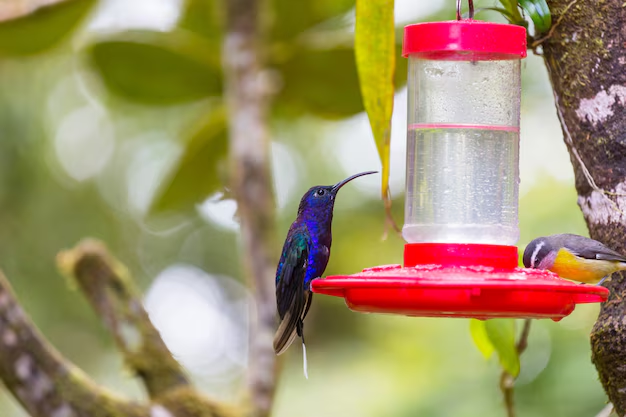How to Keep Hummingbird Sugar Water Fresh in Your Refrigerator 🐦
Welcoming hummingbirds into your garden is a delightful experience. These vibrant creatures need the energy from nectar to sustain their high metabolism, and providing them with sugar water can attract them to your backyard. However, ensuring the sugar water remains fresh is crucial for their health. Many wonder: how long does hummingbird sugar water last in the refrigerator? Let's explore this question and provide tips for proper storage, preparation, and safety to keep your visiting hummingbirds healthy and happy.
The Lifespan of Hummingbird Sugar Water
How Long Can You Store It in the Fridge?
Hummingbird sugar water, when refrigerated, can last between 1 to 2 weeks, depending on several factors, including how it's prepared and stored. Refrigeration slows bacteria and yeast growth, keeping the nectar fresher for longer compared to room temperature storage.
Factors Affecting Shelf Life
Sugar-to-Water Ratio: The most common recipe calls for a 1:4 sugar-to-water ratio (one part sugar to four parts water). This concentration mimics natural nectar and helps prevent bacterial growth.
Boiling the Water: Boiling the water before mixing it with sugar can prolong the mixture’s shelf life. This process eradicates impurities and slows the growth of unwanted organisms.
Storage Containers: Using clean, airtight containers reduces the exposure to air and contaminants, helping to preserve freshness.
Importance of Freshness
Feeding hummingbirds with stale or contaminated sugar water can harm them. Fresh sugar water ensures these delicate birds receive the energy they need without ingesting harmful bacteria or mold.
Proper Preparation and Storage Techniques
Preparing the Perfect Batch
Ingredients: Use plain white granulated sugar. Avoid substitutes like honey, brown sugar, or artificial sweeteners, as they are harmful to hummingbirds.
Boiling: Once your water reaches a boil, remove it from the heat and stir in the sugar until completely dissolved. Let it cool before transferring it to a storage container or feeder.
Storing for Longevity
Choose the Right Container: Opt for glass or BPA-free plastic containers with tight seals.
Label and Date: Always label the nectar container with the date of preparation to keep track of its freshness.
Refrigeration Location: Store the sugar water at the back of the refrigerator where temperatures are the most consistent.
Tips for Optimal Feeder Maintenance
Regular Cleaning: Clean feeders every few days with hot water and a bottle brush, especially in warm weather, to prevent mold and bacteria buildup.
Refilling Schedule: During cooler months, you can replace the nectar every 5-7 days, while in warmer climates, every 2-3 days is optimal.
Warning Signs: When to Discard Sugar Water
Visual and Olfactory Cues
Cloudiness: Sugar water should be clear. When it turns cloudy, it's a sign of fermentation, and should be replaced.
Mold and Debris: Black spots or any debris inside the feeder is a clear indicator of mold growth.
Unpleasant Odor: Fresh nectar shouldn’t have an odor. If it has a sour or off smell, discard it immediately.
Tips for Preventive Care
Daily Checkups: Regularly inspect feeders for signs of contamination or spoilage.
Feeders with Shade: Place feeders in shady spots to slow down the rate of sugar water spoilage.
Exploring Related Topics
Understanding Hummingbird Diets
While sugar water is a significant supplemental food source, hummingbirds also thrive on natural nectar, insects, and spiders. A diverse diet supports their metabolism and energy needs.
Gardening for Hummingbirds
Enhance your garden to become a hummingbird haven:
Native Flowers: Planting nectar-rich native flowers will naturally draw hummingbirds to your garden. Consider species like red columbine, bee balm, and trumpet vine.
Avoid Pesticides: Limit or eliminate pesticides to protect the insects that serve as an essential protein source for hummingbirds.
DIY Feeder Ideas
If store-bought feeders aren't an option, you can design homemade versions using:
Recycled Bottles or Jars: Ensure they are properly cleaned and modified to allow for easy refilling and hanging.
Creative Designs: Use colorful, waterproof paints to attract hummingbirds.
Summary of Key Points 📝
- Refrigerate nectar up to 2 weeks for freshness.
- Use a 1:4 sugar-to-water ratio—stick to white sugar and boiled water.
- Store in airtight, dated containers at the back of the fridge.
- Clean and refill feeders every few days.
- Place feeders in shady areas to prolong the sugar water’s shelf life.
Caring for hummingbirds by maintaining fresh and safe feeding environments is a rewarding effort. With these guidelines, you can ensure that your backyard remains an inviting stopover for these enchanting creatures. By understanding proper storage, preparation, and maintenance techniques, you'll not only support the well-being of hummingbirds but also enjoy their vibrant visits more frequently. 😍🐦
